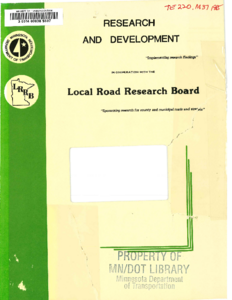Research Review Volume III: The Implementation Status of the Minnesota Department of Transportation Research Projects (Special Studies No. 265-382)
Date Created
1986-04
Description
Thickness Design of Low-Volume Bituminous-Surfaced Roads: Appendices
Date Created
1985-10
Report Number
86-07A
Description
Thickness Design of Low-Volume Bituminous-Surfaced Roads
Date Created
1985-10
Report Number
86-07
Description
Bridge Drainage Systems and Discharge to Waterways
Date Created
2023-06
Report Number
TRS 2304
Description
Pavement Rehabilitation - A Guide for Minnesota Counties and Cities
Date Created
1989-08
Report Number
89-01
Description








